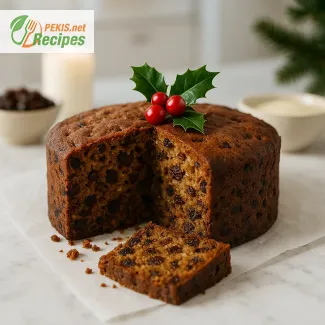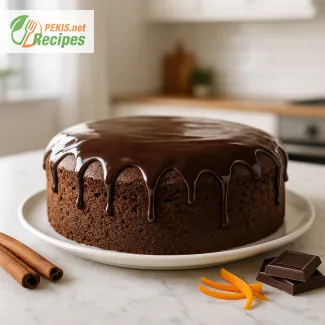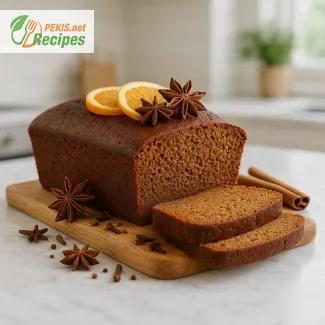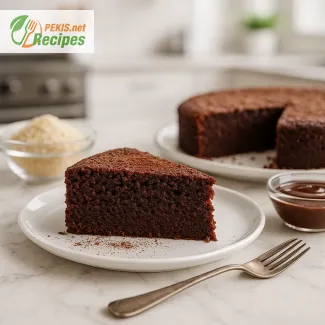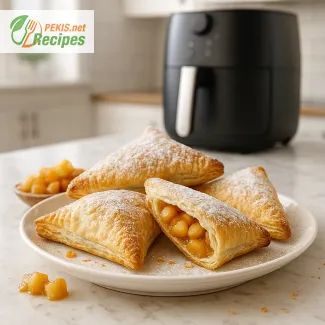Serves 8 with 25 minutes prep, 45 minutes baking, and a total time of 70 minutes. The chestnut cake with vanilla cream delivers a moist, nutty crumb layered with silky vanilla filling, finished optionally with whipped cream and grated chocolate. Its balance of earthy chestnuts and delicate vanilla makes it an elegant autumn centerpiece that stays fresh for 2 days at room temperature or up to 2 months frozen. Perfect for gatherings, this cake offers both comforting tradition and refined flavor.
PEKIS – professional chef and recipe developer with over 25 years of experience in baking, specializing in European and international cuisine. For this chestnut cake with vanilla cream, I drew on my background working with seasonal desserts, focusing on the natural sweetness of chestnuts and the smooth elegance of vanilla cream to create a cake that feels both traditional and refined.
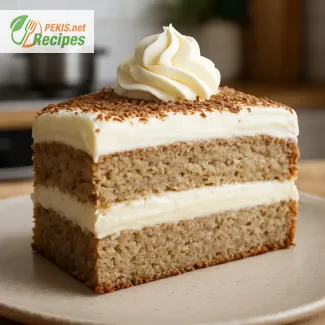
Autumn indulgence with chestnuts and vanilla
A velvety cake that captures the essence of the season
The chestnut cake with vanilla cream embodies the warmth and coziness of autumn in every bite. Its texture is naturally moist thanks to the richness of chestnuts, which lend a subtle nuttiness that pairs harmoniously with the silkiness of vanilla cream. Unlike heavier chocolate-based desserts, this creation balances earthy depth with delicate sweetness, making it an elegant centerpiece for gatherings or a comforting treat on crisp evenings.
The cultural and historical background of chestnut desserts
Chestnuts have been cultivated in Europe and Asia for centuries, often referred to as the “bread of the poor” in rural regions because of their versatility and abundance. In mountainous areas of Italy, France, and Central Europe, chestnuts were ground into flour to bake breads and cakes, providing sustenance during colder months. The tradition of combining chestnuts and vanilla dates back to the 18th and 19th centuries, when refined sugar and exotic spices became more accessible. This fusion created desserts that were both rustic and refined, much like the cake we enjoy today.
Textures and flavors that define the recipe
- Chestnuts add natural sweetness, a creamy mouthfeel, and a rustic autumn flavor.
- Vanilla cream provides smooth contrast, enhancing the nuttiness while delivering light sweetness.
- Butter and eggs build structure and give the cake its tender crumb.
- Sugar balances chestnut’s earthy notes without overwhelming them.
- Whipped cream or mascarpone can be folded into the filling for extra silkiness.
This layered combination makes the dessert satisfying yet airy, ideal for those who enjoy sophisticated pastries that remain approachable.
Why you will love this chestnut cake
- A seasonal dessert that highlights autumn’s best flavors.
- Moist and tender texture with a refined finish.
- Elegant yet simple, suitable for family tables or festive occasions.
- Versatile enough to pair with coffee, tea, or dessert wines.
- A unique alternative to traditional chocolate or fruit cakes.
Creative variations to try
- Chocolate drizzle: Add a thin layer of dark chocolate glaze for contrast.
- Citrus twist: Infuse the vanilla cream with orange zest for freshness.
- Nutty layers: Incorporate hazelnuts or almonds for extra crunch.
- Festive version: Add a splash of rum or brandy to the cream for a holiday touch.
- Mini cakes: Bake in individual molds for a modern dessert presentation.
Storage and make-ahead tips
- At room temperature: Keeps well for up to 2 days in an airtight container.
- In the refrigerator: Store covered for up to 4 days.
- Freezing: Wrap slices tightly and freeze for up to 2 months.
- Reheating: Warm gently in the oven at 150 °C (300 °F) for 8–10 minutes to revive the softness.
Related seasonal inspiration
If you enjoy the combination of chestnuts and vanilla, there is also a recipe for Chestnut panna cotta with vanilla sauce for autumn days, which highlights similar flavors in a lighter, chilled dessert form.
A dessert enriched by seasonal entities
This cake represents more than just sweetness—it connects chestnuts, a staple of European autumn harvests, with vanilla, one of the world’s most cherished spices. Together, they form a timeless pairing that continues to inspire chefs and home bakers alike. The result is a creation that feels both nostalgic and contemporary, honoring culinary traditions while appealing to today’s love of authentic seasonal desserts.
- Preheat the oven to 180 °C (350 °F). Grease and line a round cake tin with parchment paper.
- Mash the cooked chestnuts until smooth. Set aside.
- In a large bowl, beat the softened butter with sugar until pale and fluffy. Add the eggs one at a time, mixing well after each addition.
- Stir in the chestnut purée and vanilla extract until evenly combined.
- In a separate bowl, sift together the flour, baking powder, and salt. Gradually fold into the wet mixture, alternating with the milk, until the batter is smooth.
- Pour the batter into the prepared tin and bake for 40–45 minutes, or until a toothpick inserted in the center comes out clean. Allow to cool completely before assembling.
- For the vanilla cream: Heat the milk with the vanilla pod until steaming (do not boil). In a bowl, whisk the yolks with sugar and cornstarch until thick. Gradually add the hot milk, whisking continuously. Return the mixture to the saucepan and cook over medium heat until thickened. Remove from heat and stir in butter. Cool completely.
- Slice the cooled cake horizontally into two layers. Spread half of the vanilla cream over the bottom layer, place the top layer on, and cover with the remaining cream.
- Decorate with whipped cream and grated chocolate if desired.
FAQ questionCan I use chestnut flour instead of whole chestnuts or purée?
Yes—but use it differently. Replace 25–30% of the wheat flour with chestnut flour (about 50–60 g) and add 30–40 ml extra milk to keep the batter moist. If you want to mirror the original texture exactly, use unsweetened chestnut purée (or cooked, finely mashed chestnuts) for the best creamy, nutty crumb.
FAQ questionHow do I keep the cake moist and prevent dryness?
Aim for 180 °C and start checking doneness at 40 minutes; remove the cake when a toothpick shows a few moist crumbs. Use room-temperature butter and eggs, don’t over-mix once flour goes in, and let the baked layer cool in the tin for 10 minutes before unmoulding. For extra moisture, lightly brush layers with a warm vanilla milk (a splash of milk with a little sugar and vanilla) before adding cream.
FAQ questionWhat’s the key to a smooth, stable vanilla cream filling?
Cook the custard until it thickly coats the back of a spoon and shows slow bubbles. Whisk in butter off the heat for silkiness, then cool quickly and press film directly on the surface to prevent skin. Chill until set before spreading. For a lighter option, fold in a little whipped cream once cold; for extra stability (for slicing), keep it as pure pastry cream.
FAQ questionCan I make it gluten-free or dairy-free without losing the texture?
For gluten-free, use a 1:1 gluten-free flour blend and keep chestnut purée as written; add 1–2 tbsp extra milk if the batter seems thick. For dairy-free, swap butter for a good plant butter, milk for oat or almond milk, and finish with coconut cream instead of whipped cream. The cake stays tender because chestnuts add natural moisture.
FAQ questionHow far ahead can I prepare it, and what’s the best way to store?
Bake the cake a day ahead and keep it wrapped; assemble with cream on the day of serving for the neatest slices. It keeps 2 days at room temperature, up to 4 days refrigerated, and freezes (well wrapped, in slices) for 2 months. To refresh, warm a slice at 150 °C for 8–10 minutes to revive softness.
FAQ questionWhat pan size works best, and how do I adjust baking?
A standard 20–22 cm round tin gives a good height for splitting. For a 24 cm tin, expect a slightly shorter layer and check 5 minutes earlier. For cupcakes, bake 18–22 minutes. Always use parchment and level the batter for even rise.
FAQ questionCan I add chocolate or spices without overpowering the chestnuts?
Yes—keep additions measured. A thin dark-chocolate drizzle or 20–30 g cocoa sifted with the flour adds depth. For spice, try ½ tsp cinnamon or a pinch of nutmeg. Fresh orange zest in the cream lends brightness without masking the chestnut-vanilla pairing.
FAQ questionWhat if I only have canned chestnuts or ready-made purée?
Use vacuum-packed or canned chestnuts by blending to a smooth purée with a little milk. If using sweetened commercial purée, reduce the cake’s sugar by 20–30 g and taste the vanilla cream before adding all the sugar. The goal is a balanced sweetness that lets the chestnut flavor shine.
The combination of chestnuts and vanilla cream creates a dessert that feels timeless yet modern. Its soft, nutty crumb and smooth custard filling highlight the richness of autumn produce, offering both comfort and elegance in a single slice. Every element of this cake reflects balance—between sweetness and depth, between rustic simplicity and refined presentation.
Serving it during the cooler months makes it even more special. The natural sweetness of chestnuts pairs perfectly with the gentle aroma of vanilla, making it a centerpiece for gatherings or an indulgence with afternoon coffee. The cake also adapts well to variations, from a light dusting of chocolate to the addition of citrus zest for freshness.
Practicality is another reason this dessert stands out. With clear steps, accessible ingredients, and flexible storage options, it can be made ahead of time without losing flavor or texture. The ability to freeze portions ensures that this cake is not only delicious but also convenient for busy households.
In the end, the chestnut cake with vanilla cream represents more than just a sweet treat. It brings together seasonal authenticity, culinary tradition, and versatility, making it a dessert that appeals across generations and occasions. Its flavors speak of autumn’s abundance, while its elegance ensures it will remain a classic choice for years to come.
Allergens present in the recipe
- Gluten (wheat flour)
- Eggs
- Dairy (butter, milk, cream)
Tips for allergen-free alternatives
- Replace wheat flour with gluten-free all-purpose blend.
- Substitute dairy with plant-based butter and oat or almond milk.
- Use whipped coconut cream instead of dairy cream.
- Replace eggs with flaxseed or chia seed mixture (1 tbsp ground seeds + 3 tbsp water per egg).
- Vitamin A: 180 µg – supports eye health and immune function
- Vitamin C: 6 mg – boosts immunity and aids collagen production
- Vitamin B6: 0.3 mg – helps energy metabolism
- Iron: 2.4 mg – contributes to red blood cell formation
- Magnesium: 45 mg – supports muscle and nerve function
- Potassium: 380 mg – important for fluid balance and heart health
- Calcium: 65 mg – essential for strong bones and teeth
- Polyphenols (from chestnuts): 85 mg – reduce oxidative stress and inflammation
- Flavonoids (from chocolate decoration): 40 mg – improve cardiovascular health
- Vitamin E: 1.2 mg – protects cells from free radical damage
